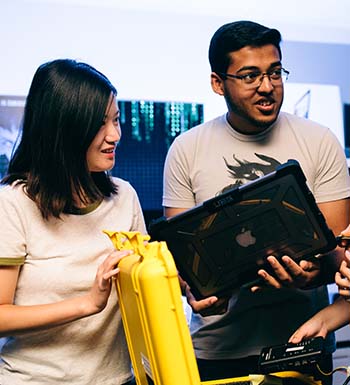Theory-based applied learning
In theory-based applied learning, students study a principle or idea on which the practice of an activity is based, and then they apply it through in-class exercises and laboratory activities. In other words, learning by doing. This hands-on approach has always been the hallmark of the college, and the Polytechnic transformation has strengthened it even further.
Over 90 percent of Polytechnic courses now reflect this core approach. For example, mechanical engineering technology and construction management technology students might study the area moment of inertia to learn about how a beam’s cross-sectional shape affects its stiffness before they build a device or structure that will be subjected to heavy loads. For course material that is less conducive to “hands-on” lab work, in-class case studies and role-playing are popular applied-learning techniques.
No more 2D theorizing
When it comes to learning the physics of multibody mechanisms, a static two-dimensional illustration on a whiteboard can only do so much. The illustration can define components, such as gears, cams and connecting links. It can also specify how these components connect to each other with symbolic joints. However, such a static, two-dimensional illustration cannot demonstrate real mechanical components or the real motion of various mechanisms in a three-dimensional environment. Its very existence is theoretical because – as a line drawing – the mechanism itself does not exist. Without actually seeing or touching the mechanisms, students usually have a difficult time understanding how the mechanical components and joints are configured and how the mechanisms move and work.
Xiumin Diao, assistant professor of engineering technology, teaches Applied Mechanism Kinematics and Dynamics. The class is no longer a chapter-by-chapter lecture of topics listed in the textbook.
To modernize the teaching method, he uses clear, plastic, box-like cases that can house any combination of connected mechanical components, such as gears, levers and cranks. These example mechanisms can clearly demonstrate the configuration of mechanical components and joints. The contents of each mechanism are removable, allowing student teams to disassemble and reassemble the mechanism in different configurations, depending on the assignment’s specifications. Students work in groups to discuss assignments and troubleshoot problems. They devise solutions by manipulating the various components, taking into account any physical limitations, such as size constraints, outlined in the case studies.
- Xiumin Diao
“The class is no longer a chapter-by-chapter lecture of topics listed in the textbook,” said Diao.
By incorporating these example mechanisms in his class, Diao delivers advanced, technical lessons in a more engaging, dynamic, hands-on manner… as his students learn by doing.
Hands-on theoretical foundation fights cyber crime
The Department of Computer and Information Technology introduces students majoring in cybersecurity to cyber criminology, which includes the study of theories related to crime, psychology, deviance and sociology.
“Many of the theories that apply to crime were created decades before the Internet existed,” said Kathryn Seigfried-Spellar, assistant professor of computer and information technology, “but students explore whether those theories apply to modern-day cybercrimes like cyberbullying, hacktivism and the creation of ransomware and malware.”
Researching why people engage in cybercrimes provides a theoretical foundation for students’ hands-on work in cyber forensics and advanced security. In cyber forensics, students learn and practice with the tools and techniques used in computer forensic investigations and cybercrime scene analysis. The cybersecurity major also includes hands-on experience in network penetration testing and vulnerability analysis.
All indications point to the successful transformation of the Polytechnic.
With a focus on innovative learning methods, hands-on experiences and industry partnerships, these 10 Elements of Transformation drive the Polytechnic Institute’s dedication to impactful technology education.

.svg)

